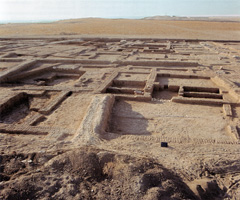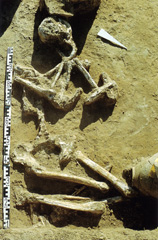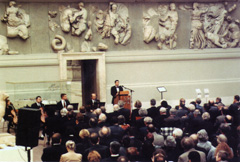» Mitgliedschaft
» Öffentlichkeitsarbeit
» Angebote für Schulen
» Satzung
» Umsetzung DSGVO
» Archivnutzung
» Kontakt
» Unterstützen
English Sites
» History of the DOG» Structure and Aims
After a final General Meeting during the Second World War on 7 June 1943, the DOG was re-founded in 1947. The chairman was now Walter Andrae, former Director of the Museum of the Ancient Near East. Already by the 1950s the DOG was able to recommence excavation work in Hattusa and Uruk, even though the German Archaeological Institute now provided the mainstay for the organisational side and funding was covered by the German Research Council. For many years the findings from its activities continued however still to be largely published in the Mitteilungen der Deutschen Orient-Gesellschaft and in the academic series put out by the DOG itself. In addition, in the 1990s Rainer Czichon conducted a survey of the area surrounding Hattusa that was co-funded by the DOG, and which aimed at drawing up a regional history of the area around the Hittite capital from the Neolithic age up to the Byzantine Period.
 |
| Habuba Kabira south, view over the excavation site with mud brick walls, © DOG / Dr. Eva Nagel-Strommenger |
The opportunity arose for the DOG to perform new excavations solely under its own auspices in the late 1960s when a dam project on the Middle Euphrates in Syria necessitated rescue excavations. With the generous funding of the Volkswagen Foundation, it was possible to carry out highly successful field work in Habuba Kabira on the western banks of the Euphrates and Tall Munbaqa on the eastern banks for many years from 1969 onward.
Under the direction of Eva Strommenger, the dig in Habuba Kabira led to the first instance of a Syrian city from the Uruk Period – dating from in the 4th century BCE - being extensively uncovered, complete with the main wall and curtain wall, gates, administrative centre, residential districts and workshop areas. Furthermore, following initial campaigns under Ernst Heinrich and Winfried Orthmann in Tall Munbaqa, since 1978 Dittmar Machule has explored a Bronze Age settlement and urban complex there dating from the 3rd and 2nd centuries BCE. Once again, urbanistic issues have had a major bearing on the research.
 |
| Tall Ahmad al-Hattu, individual burial in the more recent row of cemetery tombs, © DOG / Prof. Dr. Dietrich Sürenhagen |
After finishing her work in Habuba Kabira, in 1980 Eva Strommenger was able with the financial support of the German Research Council to begin a new DOG dig on the Tall Bi'a on the outskirts of Raqqa. Located there was the ancient city of Tuttul, once a centre of the Dagan cult.
Parallel to its long archaeological digs extending over the years, the DOG undertook two more shorter-term rescue excavations in 1978-1980 and again in 1989 that were necessitated by dam projects. In Tall Ahmad al-Hattu in Iraq, 160 km north-east of Baghdad, the remains of a settlement with a cemetery from the older Early Dynastic Period (3rd century BCE) could be found, as could a village settlement in Syria on the Tall Mulla Matar in the Lower Habur Valley. Both originated from the Halaf Period (5th century BCE.), and in both cases Dietrich Sürenhagen directed the excavations.
For some years now the DOG has once again funded archaeological field research in Anatolia. The DOG is involved through a cooperation agreement in the explorations begun in 1992 by Andreas Müller-Karpe at Kusakli, south of Sivas - the Hittite Sarissa - and is responsible for examining the cuneiform tablets.
The main thrust of the excavation activities continues however to be directed to Syria, where four excavations are currently being conducted in cooperation with the DOG.
At the same time the DOG has continued to dedicate itself to analysing and interpreting the finds and results reaped by the large-scale excavations done in its pioneering days. Special mention is due here to the Ashur Project under the direction of Johannes Renger and with the backing of the German Research Council, which is aimed at working through and publishing the material from Andrae's excavations in the Assyrian capital. The first major excavation by the DOG, Koldewey's explorations in Babylon, was for its part the topic of an international colloquium held by the DOG in 1998. International colloquiums on specific topics, such as the "Oriental Town" or "Cultures of Knowledge in the Ancient Orient", have been conducted by the DOG with great success every two years since 1996.
 |
| Centennial Celebrations of the DOG in the Pergamon Room, ©DOG |
On 23 March 1998, the DOG was able to celebrate its hundredth anniversary in the presence of the President of the Federal Republic with a ceremony in the Pergamon Room on the Museumsinsel in Berlin.
Since its re-founding in 1947, and especially in the last few years, the membership of the DOG undergone constant growth. With public talks, educational trips and the new magazine entitled Alter Orient aktuell, the DOG wishes to honour its statutes and appeal not only to specialists but increasingly to interested amateurs. In view of the growing danger to archaeological monuments in the Orient posed by illegal excavations and landscape interventions, field research in the countries of the Near East continues to share top priority with the DOG's publicity work. At present the DOG has around 950 members.
Source: Gernot Wilhelm (ed.), Zwischen Tigris und Nil. 100 Jahre Ausgrabungen der DOG in Vorderasien and Ägypten, Mainz, 1998.